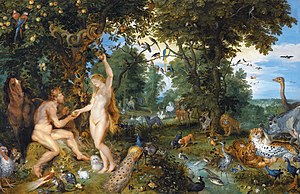The Garden of Eden with the Fall of Man
| The Garden of Eden with the Fall of Man | |
|---|---|
 | |
| Artist | Peter Paul Rubens, Jan Brueghel the Elder |
| Year | c. 1615 |
| Medium | Oil on panel |
| Dimensions | 74.3 cm × 114.7 cm (29.3 in × 45.2 in) |
| Location | Mauritshuis, The Hague |
The Garden of Eden with the Fall of Man or The Earthly Paradise with the Fall of Adam and Eve (ca. 1615) is a painting by Peter Paul Rubens (figures) and Jan Brueghel the Elder (flora and fauna). It is housed in the Mauritshuis art museum in The Hague, Netherlands. The painting depicts the moment just before the consumption of forbidden fruit and the fall of man.
Adam and Eve are depicted beneath the tree of the knowledge of good and evil, where various fruits grow. On the opposite side the tree of life is depicted, also laden with fruits. The scene is a reference to Genesis 2:8–14. A monkey biting an apple to the left symbolizes sin.[1] The sanguine monkey next to Adam is the hotspur who cannot resist temptation, while the choleric cat near Eve's heels represents cruel cunning.[1] In Christian symbolism, several grapes in the foliage behind Adam and Eve represent Christ's death on the cross, as wine represents his blood.[1]
References[]
External links[]
- 17th-century painting stubs
- 1617 paintings
- Birds in art
- Cattle in art
- Paintings depicting Adam and Eve
- Horses in art
- Lions in art
- Nude art
- Paintings by Peter Paul Rubens
- Paintings by Jan Brueghel the Elder
- Paintings in the collection of the Mauritshuis
- Rabbits and hares in art
- Snakes in art
- Tigers in art
- Monkeys in art
- Water in art